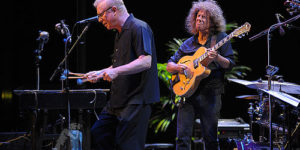In today’s Wall Street Journal “Sightings” column, I pay tribute to Gary Burton, who is retiring later this month. Here’s an excerpt.
* * *
Gary Burton, the foremost living jazz vibraphone player, announced last week in an interview with the Miami Herald that his current concert tour, which ends in Indianapolis on March 17, will be his last. At 74 and after six heart operations, he’s decided that he’s no longer able to play as well as he’d like, and so he’s keeping a promise that he made four years ago in “Learning to Listen,” his marvelous autobiography: “I don’t think I’ve hit the point where I need to quit, but I’m sure that eventually, the time will come. I just want to be clear-headed and strong enough to step back when it does.”
 I deeply admire Mr. Burton for quitting while he’s still—as far as the rest of us can tell—at the top of his game. Too many performing artists find it impossible to walk away from the stage, even after their powers have been diminished to the point of public embarrassment by advancing age. (That’s what happened to Anita O’Day, whose last public performances were a pitiful debacle.) Not so Mr. Burton. He’s retiring the way he’s lived, with courage and grace….
I deeply admire Mr. Burton for quitting while he’s still—as far as the rest of us can tell—at the top of his game. Too many performing artists find it impossible to walk away from the stage, even after their powers have been diminished to the point of public embarrassment by advancing age. (That’s what happened to Anita O’Day, whose last public performances were a pitiful debacle.) Not so Mr. Burton. He’s retiring the way he’s lived, with courage and grace….
It’s hard to know where to start summing up Mr. Burton, for he is that rarity of rarities, a consummate virtuoso who was equally important as a stylistic innovator, and whose parallel career as a teacher and academic administrator has been scarcely less noteworthy (he spent 33 years at Boston’s Berklee College of Music, his alma mater, ending as its executive vice president). The Gary Burton Quartet, which he put together in 1967 after spending four years as a sideman with Stan Getz and George Shearing, was the first jazz combo of consequence to incorporate elements of rock into its musical vocabulary. In such quartet albums as “Duster” and “Country Roads and Other Places,” Mr. Burton and the bassist Steve Swallow, his longtime musical partner, showed that jazz didn’t have to stick to the well-trod path of straight-ahead swing. The results were hugely influential on a generation of up-and-coming jazz instrumentalists who longed to put a fresh spin on the music they loved—starting with Pat Metheny, who joined Mr. Burton’s group in 1974 and went on to become the most influential jazz-rock guitarist of his own generation.
Mr. Burton’s vibraphone was, of course, the signature sound of his group, and it is as distinctive now as it was a half-century ago. Playing with four mallets instead of the long-customary two, he fills the air with billowing pastel washes of iridescent harmony, miraculously transforming a percussion instrument into a font of cool, silvery lyricism….
* * *
Read the whole thing here.
The Gary Burton Quartet plays “General Mojo’s Well-Laid Plan,” a composition by Steve Swallow, in Berlin in 1967. The other players are Swallow on bass, Larry Coryell on guitar, and Bob Moses on drums. This composition was first recorded that same year on Duster, the quartet’s debut album for RCA:
Gary Burton plays an unaccompanied solo version of Antonio Carlos Jobim’s “Chega de Saudade” in 1971:
Gary Burton and Pat Metheny play Steve Swallow’s “Falling Grace”:
